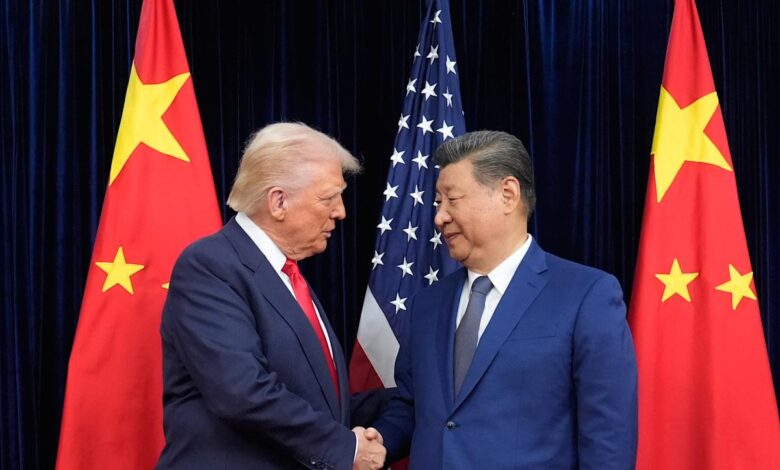What are rare earth minerals, and why are they important?

President Trump’s continuing efforts to secure rare earth mineral deals with China, Malaysia, Thailand, Vietnam, Australia, Cambodia, and even Ukraine have brought the little-known elements back to the world’s attention, with increased awareness of just how critical they are in today’s tech-dependent economy.
Under an Oct. 30 deal with the U.S., China agreed to temporarily roll back restrictions on rare earth minerals, which are found in technologies ranging from smartphones and electric vehicles to jet fighters and radar systems.
The U.S. is heavily reliant on China for rare earth minerals, and global demand is forecast to double by 2030 as renewables, electric vehicles, and data centers become more widespread, an International Energy Agency (IEA) outlook shows.
China accounts for roughly 60% of rare earths production and controls 92% of global processing, according to the IEA. It has often used the minerals as a bargaining chip in trade disputes. In early October, China outlined more controls on exports of rare earths just weeks ahead of Trump’s meeting with Chinese leader Xi Jinping, reigniting tensions between the two countries.
China has agreed to pause export restrictions for one year as part of the recent trade agreement.
Here’s what you should know about rare earth minerals.
Also read: Thinking of buying gold? Here’s what investors should watch for.
Rare earth minerals, generally 17 elements with names that sound like prescription medicines (cerium, promethium, terbium), aren’t really scarce.
A NATO Review video entitled “Rare earths: the new oil” said, “Rare they aren’t. If you took a shovel and dug a hole in your backyard, you’d probably find some rare earth.”
What is rare, the video continued, is finding these elements in the volume required to manufacture the devices they are found in: vehicles, batteries, consumer electronics, and more.
The video was produced in 2011. Yet, 14 years later, for many, we’re just now learning about these critical elements, which are key ingredients in modern technology and clean-energy applications — and in defense and aerospace systems, such as jet engines, radar, and night vision.
Although they are not especially rare, extracting them is difficult and costly, with the mining process releasing toxic chemicals into the environment.
With a nearly 20-year on-ramp to open a new rare earth mineral mine, the industries dependent on these elements include consumer electronics, medical equipment providers such as MRI imaging, government defense programs, and AI.
Read next: Gold alternatives? How to invest in silver, platinum, and palladium.
Considering the wide range of uses, there is no doubt that rare earth minerals are a matter of national security, according to an analysis by the Bipartisan Policy Center. The issue: A majority of rare earth elements are imported — primarily from China.
“Onshoring the supply chain for critical minerals is important for both national and energy security reasons, particularly because of their use in energy and defense applications,” the BPC wrote. Rare earth minerals make today’s high-tech applications lighter, faster, and more useful, including batteries, magnets, microwaves, lasers — and F-35 fighter jets and Virginia-class submarines.
As an example of the government’s critical reliance on rare earth minerals, Las Vegas-based MP Materials, which operates the only rare earth mine in the U.S. and the second-largest in the world, formed a public-private partnership with the Department of Defense in July 2025.
The U.S. government becoming a major shareholder in a critical minerals company was a deal that officials said would be “the first of many.”
Neal Dingmann, an analyst at William Blair who covers rare earth mineral stocks, said in a Yahoo Finance interview on Nov. 2 that American companies are unlikely to be able to compete with China in the foreseeable future.
“Anything that they’re going to supply is going to be two to three times the cost [of China],” Dingmann said. He adds that any investment in a domestic rare earth company is going to take a while to see sizable returns. “You’re talking probably a minimum of two to three years. I think what you might see, much like the president signed four other agreements with Southeast Asian countries, is that potentially a U.S. company could partner with any or all of those. Then you’re maybe talking a year, maybe two at most. I think these allied partnerships are going to be a key behind this.”
Dingmann named NeoCorp (NB), USA Rare Earth (USAR), American Resources (AREC), and United States Antimony Corporation (UAMY) as names to consider.
His favorite?
“I think the one that is probably nearest-term is USA Rare Earth,” Dingmann said. “They just recently purchased, but haven’t closed yet, on a very strategic UK company called LCM, Less Common Metals, that is going to provide the metals and alloys. Number two, they have a very large magnet factory in Stillwater, Oklahoma, that’s going to start up right around year-end.”
Read more: Create a stock investing strategy in 3 steps






